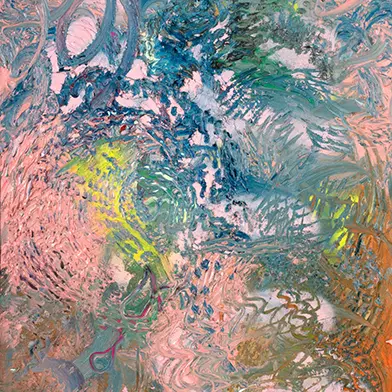

(photo: Renee Parkhurst)
Milena Muzquiz (b. Mexico 1972) grew up between the sister cities of Tijuana and San Diego, on either side of the most visited border in the world. There is a little piece of ocean in between that she could feasibly have swum across, Muzquiz tells me, but she took the Interstate 5, moving between high school and home, no ID required. ‘Learning to navigate extremes was part of my life and still is: everything gets mixed up, culturally. There’s nothing purist about my work.’
While notions of nationalism and identity are thrown up by the title of Muzquiz’ first major UK show, “California” refers directly to ‘a kind of Freudian narrative’ that emerged as the multi-media artist embarked on this new body of work, comprising twenty-one ceramic vessels and a series of large-scale paintings. She describes vivid recollections of her childhood in the Californian landscape, visits to dilapidated beach clubs and banal shopping malls, and the cacophonous selling of souvenirs at the Mexican border.
‘It was very intense in the car. Objects would appear and disappear at the window – piggy banks, gnomes, Christ figures, Mickey Mouse, and the Virgin of Guadalupe’, an icon invented to persuade the indigenous people to embrace Catholicism, known as the Virgin of the Poor. ‘She was very Mexican, covered in stars and lights. You’re taking it all in super-fast and I guess I repeat that experience as I work, grabbing images, collaging, seeing what works.’
Muzquiz cuts and scores her clay, applying pieces to the vessels like magazine cut-outs, layering colours, patterns, images, tendrils, baubles and pendants to create complex self-portraits so full of movement they are almost performative. This is unsurprising, given the 15 years Muzquiz spent as one half of the art band Los Super Elegantes. Muzquiz and Martiano Lopez-Cortez performed their signature blend of theatre, dance and punk-mariachi-hip-hop at museums, galleries, art fairs and the Whitney Biennale (2004), gaining an international reputation as a must-see art world fixture.
When they split, in 2009, Muzquiz found that ‘it was natural for me to grab a piece of clay and figure out what to do with it.’ Having received her BFA at the California College of Fine Arts, San Francisco, Muzquiz joined the masters programme at the Art Centre, Pasadena, where she was tutored by Mike Kelley. ‘There was a kind of Californian eco-system where we’d visit UCLA and Cal Arts for talks, and guys like Chris Burden, Ed Ruscha and John Baldessari would come to see us. But mostly I was learning from Mike’. Kelley died in 2012, aged 57, and left Muzquiz with ‘a monumental piece of advice: After all the theory he taught me, it was, “Just do something with your hands”. He realised that what mattered most was your relationship with yourself.’
Artists are continually confronted with themselves, says Muzquiz, and California’s wild, ‘non-historical’ landscape provides the requisite freedom for quiet introspection: ‘It is such a contemporary place, you can just carve out your own existence.’ But Muzquiz’ California is complicated, resonant with the loss of its Native American history. ‘California has a shallow surface and beneath it you can feel its ghosts. They are howling and hooting into the night.’ Muzquiz’ cross-border childhood and her capacity for self-reflection are contained in this evocative body of work that makes a political statement almost by default.
Sophie Hastings



